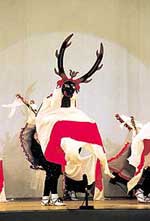
| Pseudonym reading | Suguru no oshishi oridori · Kembei |
|---|---|
| Specified type | Prefecture designation |
| Type | Intangible folk cultural property |
| Designated date | April 8, 1988 |
| Specified details | |
| quantity | |
| location | Tanohatamura Ogikubo |
| owner | |
| Holding group | Ogikubo deer dance preservation society |
| Management organization | |
| home page | Iwate's Cultural Information Encyclopedia |
Overview
This dance belongs to a dance group that dances by moving a curtain covering the body from the inside according to the lion, and is composed of eight heads alone.
It is said that the carpenter Togoro who moved from Otsugu to Ogikubo in the early modern times told that it was a monument of the Great Nenetian Buddha built in Oyodo for the Enshu year (1801 to 1803), Kanaga 5 years when the Taio Chogoro was built in Ogikubo (1852) There are still monuments of memorial service to the Buddha.
The same dance group has an unusual manner of dancing sword dance early from deer dance.
The deer dance is characterized by the fact that the deer head is representing a wild deer, and attracts attention from the history of performing arts, such as being similar to the Sae Masumi's "Back-to-back sketch of a deer dance in the southern part".
The Great Nembutsu, the main feature of Kembu dance, has the merits of the Great Nembutsu and the mouth, and 7 pairs of dancers in different groups gather different dances, sing and sing the Buddhist ceremonial Buddha, It is the underlying entertainment.
In addition, other songs that collect flowers and sen drums are also unique and show regional features.
It is danced at Ogikubo cemetery every year on the 14th of the Bon Festival and at the festival of the Raiden Shrine in May.
